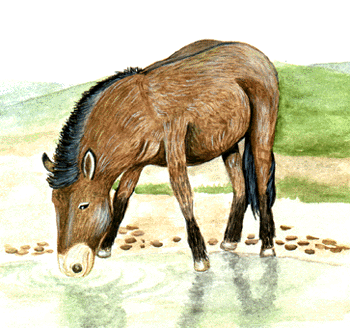Overview
 Order: Perissodactyla
Order: Perissodactyla
Family: Equidae
Species: Equus ferus przewalskii
Distribution: Recently reintroduced to Mongolia. Once found from Ural mountains to Mongolia.
Habitat: originally roamed mountainous, arid, semi-desert country with large, grassy plains.
Description: stocky body; low set shoulders which blend directly into the back, giving the horse a primitive look. Yellowish-brown coat, paler undersides, pale sandy-coloured muzzle, black tail and lower leg. Thick woolly coat in winter. The mane has no forelock but has short, stiff, black hairs which stand upright. Size: average height to withers is 12 hands i.e. 1.2m to shoulders. Weight: about 350kg.
Life-span: up to about 25 years.
Food: grass and leaves from shrubby trees.
Przewalski's horse (pronounced 'ji-vaal-ski') is the only truly wild horse left in the world. It is believed that it has changed very little since the end of the Ice Age.
It was discovered and identified in 1881 by a Russian cavalry officer and explorer, Colonel Nicolai Przhevalsky, after whom the horse is named. Obviously, local people had known it for generations before this time.
Food and Feeding
Przewalski's horse used to roam the vast grassy plains of Eurasia in large herds. Over the centuries, the herds became smaller and eventually restricted to the dry, semi-desert plains on the other side of the Altai mountains, known as the Mountains of the Yellow Horses, which form the boundary between Mongolia and China.
In the wild, the horse survives on coarse grasses, branches and leaves from hardy trees growing on the harsh plains. It feeds mainly at dusk, always on the move as it searched for food. During the winter it often has to scrape away layers of snow to find anything to eat.
At dawn, the herds return to a desert habitat to rest until the evening. As the horses moved between resting and feeding areas, they walk in a line, forming deep, well trodden paths.
Przewalski's Horse and Humans
For centuries, this horse was hunted by the Chinese and Mongolians as a source of food, and the decline of the species was speeded up when firearms reached the hands of these hunters.
Having such a wild, shy nature, the Przewalski's horse has never really been tamed by humans, and has only been semi-domesticated. When still in the wild, it had been allowed to breed with feral horses (i.e. formerly domestic horses now living wild).
This unique horse has been saved from total extinction through captive breeding in zoos. A studbook listing the horses and their ancestors helps zoos exchange animals to prevent inbreeding. There are now a few small herds living wild in Mongolia. The main threat to the continuation of these wild herds is now interbreeding with domesticated horses.
This is a real example of how humans can help to save a species from extinction (though it has to be said that humans are the main reason that Przewalski horses were in danger of extinction in the first place!) The horses' population is increasing and its status in the wild has improved markedly from 'extinct' in 1996 to 'critically endangered' by 2008 to 'Endangered' in 2011.
Credits
Image: Horse (Przewalski's) by Tanya Durrant
Infomation sourced from:
National Geographic (2015), Przewalski’s Horse [online], Available from: http://animals.nationalgeographic.com/animals/mammals/przewalskis-horse/ [accessed 30/06/2015].
Breeding
In the wild, a Przewalski's horse herd would be made up of a stallion, a few mares and young horses. Mating occurs in April or May and a single foal is born almost a year later. The foal is usually born during the night and by the morning it is strong enough to travel with the herd. If a foal lags behind, particularly if the herd is fleeing from danger, the stallion grasps the root of the foal's tail and encourages it along.
The foal is capable of grazing within a few weeks but the mare suckles it for several months, perhaps until she gives birth again. A female foal (a filly) may remain with the herd for some time. The stallion drives young males out after a year and they group up in small herds until they are about three years old, strong and mature enough to collect a harem of mares.
 Order: Perissodactyla
Order: Perissodactyla
